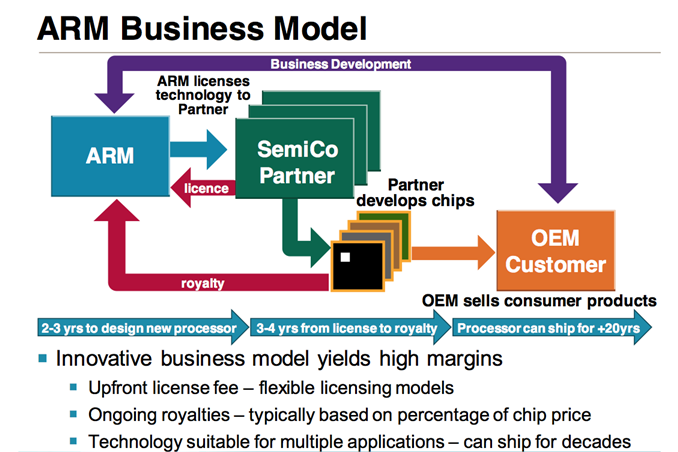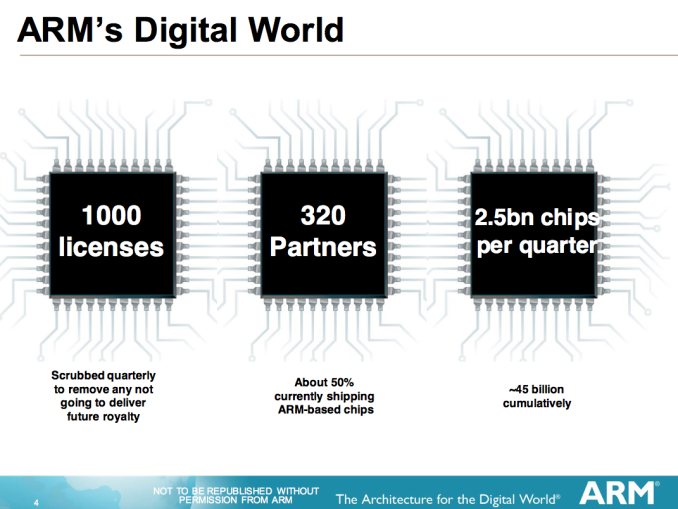The ARM Diaries, Part 1: How ARM’s Business Model Works
by Anand Lal Shimpi on June 28, 2013 12:06 AM EST
It must frustrate ARM just how much attention is given to Intel in the ultra mobile space, especially considering the chip giant’s effectively non-existent market share. Since 2008 Intel has tried, year after year, to break into smartphones and tablets with very limited success. Despite having the IP and technical know-how to do so, it wasn’t until 2012 that we saw Intel act like a company with even a sliver of a chance. Today, things are finally starting to change. Intel’s 22nm SoC process and updated Atom microarchitecture look very competitive, and we’ll see the first tablet products based on them later this year - with phones following sometime in early 2014. As Intel is about to start acting like a competitor, ARM is starting to talk a lot more about its magic.
We’ve had well over a decade of Intel sharing its beliefs with us, but this is ARM’s first attempt at doing the same. What will follow over the next few posts are a bunch of disclosures, some related some not, attempting to bring everyone up to speed on where ARM is today and where ARM will be in the near future. The best place to start is with ARM’s business model.
In the PC industry, the concept of a fabless semiconductor manufacturer isn’t unusual. NVIDIA has always been one, and now AMD is one as well. Fabless semiconductors create all of the designs for their chips, but they’re physically manufactured at a foundry partner (e.g. TSMC, Global Foundries, Samsung). The fabless semi approach greatly helps reduce costs, but your designs are ultimately at the mercy of your foundry partner. Capacity, quality of process and timeline for process are more or less out of your control. Sometimes this is a non-issue, but other times it dramatically impacts your ability to bring products to market (e.g. quality control for early TSMC 40nm, timeline for GF 28nm or early capacity for TSMC 28nm).
ARM goes one step beyond the fabless semi: it doesn’t even sell any chips into the marketplace. ARM instead, designs IP (instruction set architecture, microprocessor, graphics, interconnects) and licenses it to anyone who wants to use it. ARM’s customers will then take the IP they’ve licensed and design it into silicon. These customers can be fabless semiconductor companies or companies that own fabs.
It’s a very unique business model, especially if you compare it to that of the market share leader in the PC silicon space (Intel). From Intel’s perspective, it made the mistake of licensing the x86 ISA early on in its life, but quickly retreated from that business. It instead builds its own architectures, designs them into chips for various markets, and manufactures the designs at its own foundries. Intel is a truly vertically integrated chip design and fabrication house. It’s a lot of work, but Intel is rewarded by having extremely high margins on all of its products.
The ultra mobile world is very different, at least today. In the PC world, Intel drives platform definition and ends up being the biggest part of the BoM (Bill of Materials) as a result. In smartphones and tablets, the main applications processor is easily under 10% of the cost of the device. More often than not, we’re talking about low single digit percentages of the total BoM (e.g. $15 SoC for a $400 device, or 3.75%). Intel’s theory is that this will eventually change as silicon complexity increases inside ultra mobile devices, but until now (and likely for the near future) the market requires/enables a different sort of business model.
How ARM Works
The ARM business model is incredibly simple to understand, it’s just different than what we’re used to in the PC space. At a high level, ARM offers three different types of licenses: POP, processor and architecture.
A processor license is the license to use a microprocessor or GPU that ARM has designed. You can’t really change the design, but you get to implement it however you’d like. For example, Samsung’s Exynos 5 Octa implements four ARM Cortex A7 cores and four ARM Cortex A15 cores - these are processor licenses. ARM will provide guidelines as to how to implement these designs in silicon, but ultimately it’s up to you and your physical implementation teams to do so and get good frequency/power out of your design.
A processor optimization pack (POP), takes a processor license to the next level. If you aren’t great at physical implementations, ARM will sell you an optimized processor design that you can take and manufacture at a specific foundry which will result in some degree of guaranteed performance. If you look at what happened with the Cortex A8, Apple and Samsung had their own physical implementations of the core that resulted in better frequency/power than a lot of other designs. Apple and Samsung had access to Intrinsity who hardened the Cortex A8 design, but not all companies had the bandwidth/budget to do the same. POPs are ARM’s equivalent solution for those customers who need very good implementations but can’t do so by themselves. POPs are available for various processor/foundry/process node combinations. For example, ARM offers a 28nm HPM POP at TSMC for the Cortex A12.
The final option is an architecture license. Here, ARM would license you one of its architectures (e.g. ARMv7, ARMv8) and you’re free to take that architecture and implement it however you’d like. This is what Qualcomm does to build Krait, and what Apple did to build Swift. These microprocessors are ISA compatible with ARM’s Cortex A15 for example, but they are their own implementations of the ARM ISA. Here you basically get a book and a bunch of tests to verify compliance with the ARM ISA you’re implementing. ARM will offer some support to help you with your design, but it’s ultimately up to you to design, implement and validate your own microprocessor design.
In terms of numbers, ARM has around 1000 licenses in the market spread across 320 licensees/partners. Of those 320 licensees, only 15 of them have architecture licenses.












64 Comments
View All Comments
Arbee - Friday, June 28, 2013 - link
AMD's clones up through the 486 were true clones of the relevant Intel parts. For the Pentium Intel stopped allowing that and AMD started making their own designs, which at first weren't all that good.ShieTar - Friday, June 28, 2013 - link
Even these days, AMD is somewhat forced to at least copy the INTEL instruction set. At this point, Intel definitly profits from the situation, whatever they decide to include for their CPU, AMD needs to support soon enough in order not to fall back.fluxtatic - Monday, July 1, 2013 - link
The new arch Intel made was Itanium, as they were hoping to get away from x86. We all know how well that worked out.What put AMD behind was Intel's incredibly dirty tricks around the days the Athlon64 was stomping all over Intel - all the backroom deals with Dell and HP, among others, to keep AMD parts out of PCs. Intel would kick in significant amounts of money in both marketing dollars and straight (very illegal) kickbacks to companies that were willing to play ball.
It ended up settling a couple years ago, with Intel paying around $2 billion, as I recall, but that was far too late for the damage done to AMD.
And to Wolfpup's point - there's likely not even money changing hands between Intel and AMD these days - they've both got significant contributions to the x86 architecture that are covered by the cross-licensing agreement. However, likely a lot of the newer features Intel has developed aren't covered, and AMD has to clean-room reverse engineer them if they want to include them in their own designs.
Scannall - Friday, June 28, 2013 - link
There were many reasons for them licensing x86 at the time. And there used to be a whole lot of licensees. AMD is just the last one standing. Other manufacturers were coming up with very good and compelling CPU architectures, and there was really no standard per se. Between contract requirements, and many companies using licensed x86 IP it became the 'standard'.So it looks to me like it was far from a mistake. Use all the licensees to get your architecture king of the hill, then grind them into the grave. Big win for Intel.
rabidpeach - Saturday, June 29, 2013 - link
so arm could be early intel.1. build up cash pile thru licensing
2. buy a fab
3. make it make your exclusive next gen processor that isnt licensed
4. sell it and destroy all the commodity producers
this strategy would need intel to stay on the sidelines.
TheinsanegamerN - Sunday, June 30, 2013 - link
except amd went and sold its fab.slatanek - Friday, June 28, 2013 - link
Great article Anand! It's actually something I have been thinking for a while too (ARM). But I have to admit I miss PODCASTS too! (I'm not the only one as it seems)Callitrax - Friday, June 28, 2013 - link
I'm not so sure the statement "In the PC world, Intel ... ends up being the biggest part of the BoM (Bill of Materials)" is all that accurate. I know it hasn't been for me for 10+ years, the largest part of my BoM is I think the same as a mobile device - the display. Anybody running multiple displays or 1200+ vertical lines (which probably constitutes a large fraction of the readers here) spent spent somewhere between $300 and $800+ dollars which means that they would need an i7 at the low end or i7 extreme at the high end (+PCH) to for Intel's cut to exceed the display cost. And for that matter Samsung just topped the processor in my computer (SSD).* okay technically you could break the monitor BoM into payments to a few companies, but my panel I would guess still exceeds my cpu since the display was $600 on sale.
** and the economics get fuzzed up a little since desktop displays can last through several cpus (mine is on its 3rd cpu and 4 graphics card) whereas mobile device displays are glued to the cpu.
mitcoes - Friday, June 28, 2013 - link
it is possible we will see future ARM64 models where the SoC is plugged in, even a standard connector / format, and be able to upgrade the SoC 2 or 3 times as we do actually with desktop computers. I suggested it to several brands, and I suposse they read the suggestions, and perhaps one will do itname99 - Friday, June 28, 2013 - link
It makes zero sense to optimize for something that is cheap (and part of a cheap system). The days of replaceable cores are gone, just like the days of replaceable batteries. Complaining about them just reveals you as out of touch.There is good physics behind this, not just bitchiness. Mounting which allows devices to be plugged in and out is physically larger, uses more power, and limits frequencies and so performance. There's no point in providing it in most circumstances.
Next to go (for this sort of reason) will be replaceable RAM. It's already not part of the phone/tablet/ultrabook experience, and at some point the performance limitations (as opposed to the size and power issues) will probably mean it's also removed from mainstream desktops.
Complain all you like, but physics is physics. The impedance mismatch from these sorts of connectors is a real problem.